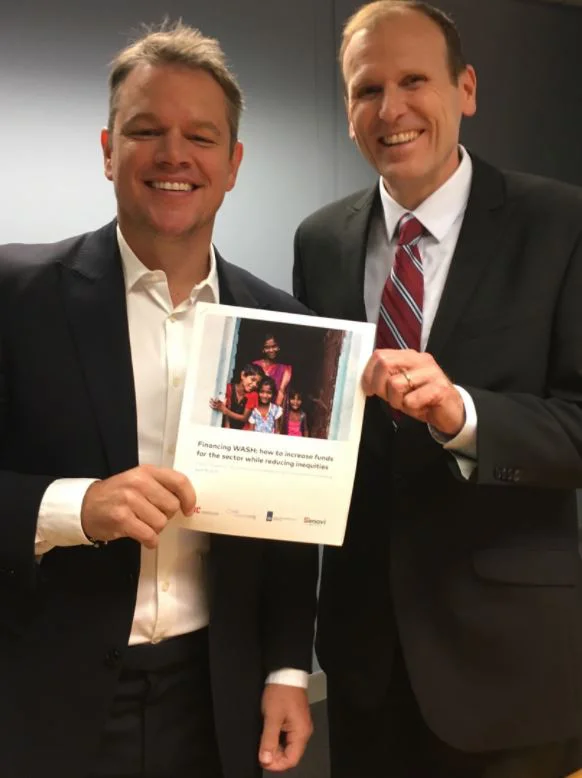Financing SDG 6
For 30 years, Water.org has been at the forefront of developing and delivering solutions to the global water crisis. Founded by Gary White and Matt Damon, we pioneer market-driven financial solutions to ensure all people have access to safe water and sanitation – giving women hope, children health and families a future. We have positively transformed the lives of more than 63 million people around the world, and together, we can change more lives.
Transforming our world: The 2030 agenda for sustainable development
Building on the momentum of the Millennium Development Goals, the Sustainable Development Goals (SDGs) are a universal call-to-action to end poverty, protect the planet and ensure that all people enjoy peace and prosperity. These goals are in place 2016 – 2030 and are ambitious in their design, being both comprehensive as well as interconnected. SDG 6 is dedicated to clean water and sanitation.
Financing SDG 6: A new paradigm in international development
According to the most recent report of the WHO/UNICEF Joint Monitoring Programme (JMP), 2.2 billion people lack access to a basic drinking water source. Moreover, 3.5 billion people — 2 in 5 — lack access to a safe toilet. While those numbers are daunting enough, SDG targets 6.1 and 6.2 set the bar higher than simply basic access, aiming instead for safely-managed access that is within a 30-minute round trip. The World Bank estimates that achieving these targets will cost approximately US $114 billion a year between now and 2030, and those are only the costs for constructing new infrastructure, not the costs of operating and maintaining infrastructure over time. Meanwhile, Official Development Assistance (ODA) hovers around US$13 billion a year – far short of what is needed. Mechanisms that strategically use donor finance to catalyze private investment – often referred to as “blended finance” – will be critical to filling the financing gap, and Water.org is well-poised to help the global community move forward.
Financing Sustainable Development Goal 6 to ensure water and sanitation for all by 2030
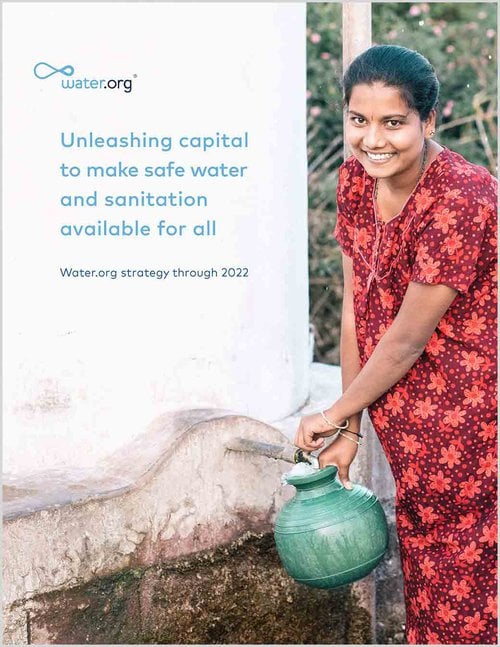
Unleashing capital to make safe water and sanitation available for all – Water.org strategy through 2022
By 2025, Water.org aspires to change 60 million lives with access to safe water and sanitation. To do this, Water.org joins forces with others to increase financing for water and sanitation, including partnering directly with institutions that serve the base of the economic pyramid, partnering to accelerate impact, and strengthening the enabling environment with and through others.
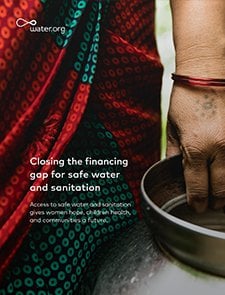
Closing the financing gap for water and sanitation — Water.org and WaterEquity's current efforts to increase access to safe water and sanitation
Closing the financing gap for water and sanitation is critical to achieving universal, sustainable, and equitable access to water and sanitation. Water.org and WaterEquity address this significant capital barrier through access to affordable financing, tapping global capital markets to attract greater resources and enabling household-level loans for water and sanitation.
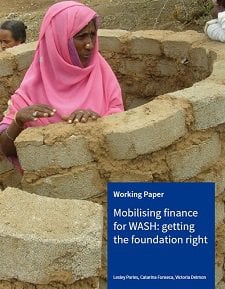
Getting the Foundation Right Working Paper — Water.org-IRC-World Bank working paper, “Mobilising finance for WASH: getting the foundation right”
Water.org collaborated with Netherlands-based IRC and the World Bank Water Global Practice to highlight that new financial mechanisms designed to mobilise finance for water and sanitation are not enough to ensure that solutions and investments made now will be sustainable over time. Without addressing foundational issues in the sector, any finance mechanism, whether public, private or blended, will be a short-term, band-aid solution and the sector will continue the cycle of dependency on external assistance rather than fixing the root causes and building self-sufficiency. (March 2019)
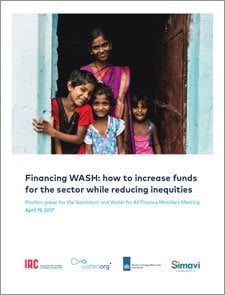
Financing SDG 6 Position Paper — Water.org-IRC position paper, “Financing WASH: how to increase funds for the sector while reducing inequities: Position paper for the Sanitation and Water for All Finance Ministers Meeting, April 20, 2017”
Water.org collaborated with Netherlands-based IRC to highlight issues critical to achieving sustainable access to water and sanitation, including: strengthening the enabling environment; utilizing micro and blended finance to their full potential; and resolving inequities in financing allocation. These recommendations support Ministers of Finance as they develop effective financing plans for their country, furthering progress toward achieving Sustainable Development Goal 6. (April 2017)
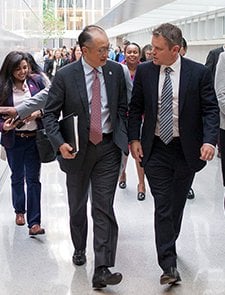
A future that leaves no one behind — Huffpost OpEd reflecting on growing momentum for innovative financing for water and sanitation
In April 2017, Water.org Co-Founders Matt Damon and Gary White participated in the World Bank High Level Meetings on financing SDG 6 to discuss the financing gap between existing funding and what it will take to achieve universal access to safely-managed water and sanitation.
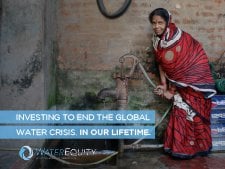
WaterEquity — Investing to end the global water crisis
WaterEquity is an innovation of Water.org that creates the opportunity for social impact investors to put their capital to work to achieve powerful social impact with financial returns. WaterEquity scales proven Water.org solutions, increasing the availability of small, affordable loans to meet the tremendous market demand for water and sanitation.
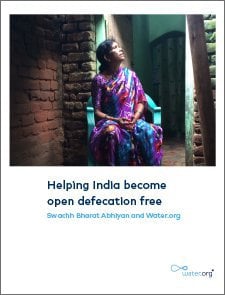
Working with government to achieve its national and global goals — Summary document of how Water.org has supported India's largest sanitation campaign
Unlocking financial flows for water and sanitation in a country cannot be achieved in a vacuum. Engaging with various levels of government and altering regulations to be more supportive – creating an ‘enabling environment’ for water and sanitation outcomes – is a critical piece of the puzzle. “Helping India become open defecation-free: Swachh Bharat Abhiyan and Water.org” outlines how Water.org collaborated with various ministries and other actors in support of India’s massive sanitation campaign to help the country make serious inroads towards its goal of becoming open defecation free by 2019.
Affordable financing for water and sanitation: the evidence base
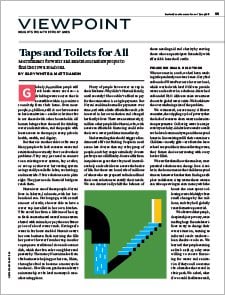
Stanford Social Innovations Review — "Taps and Toilets for All"
Globally, 844 million people still lack basic water service—a drinking water source that is accessible within a 30-minute round trip from their home. Even more people, 2.3 billion, still do not have access to basic sanitation—a toilet or latrine that is not shared with other households. Many people who lack access to water and sanitation know exactly how to solve their problems. They may just need to connect to an existing water system, buy a toilet, or set up a rainwater harvesting system using readily available labor, technology, and materials. Their solutions are in plain sight if the appropriate financial tool was in place to assist them. This article reviews the rationale behind Water.org’s innovative financing mechanism to facilitate affordable access to water and sanitation services for all, especially those at the Base of the Economic Pyramid (Spring 2018).
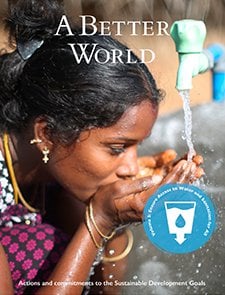
A Better World, Volume 3 — “Accelerating towards universal access to clean water and sanitation – WaterCredit and beyond”
At three times current investment levels, the amount of funding needed to achieve SDG 6 is massive. Sole reliance on government and donor financing limit the pace at which the required investments can be made. New ways of harnessing domestic capital are needed at multiple levels. One approach is to mobilize more of the poor to invest in their own solutions: while the upfront cost of a toilet or a piped water connection can easily equal a household’s entire monthly income, many are willing to invest if they can spread that cost over time. This article looks at the WaterCredit approach to mobilizing finance to work for the world’s poor as well as additional ways of supporting the services that provide water and sanitation to the base of the economic pyramid. (March 2018)
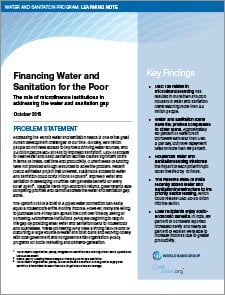
Global Learning Note — “Financing Water and Sanitation for the Poor: The role of microfinance institutions in addressing the water and sanitation gap”
Water and sanitation financing shows strong promise of supporting the ambitious Sustainable Development Goal 6 to end open defecation and ensure basic access to water and safe sanitation by 2030. Water.org and the Water and Sanitation Program of the World Bank’s Water Global Practice spotlight the positive impacts microfinance for water and sanitation provides households, microfinance institutions, governments, and low-income borrowers and their families. (October 2015)
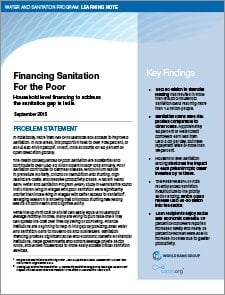
India Learning Note — “Financing Sanitation for the Poor: Household level financing to address the sanitation gap in India”
Financial institutions in India pioneered household level water and sanitation lending and have a strong track record of disbursing a large volume of toilet loans and working closely with local government and nongovernmental organization programs for social marketing and demand-generation. Water.org and the Water and Sanitation Program of the World Bank’s Water Global Practice cooperated on this Learning Note to highlight evidence and lessons learned for the Government of India and development partners to further integrate household level financing into the Clean India Campaign. (September 2015)
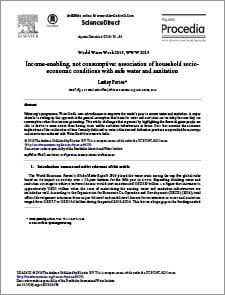
WSS loans as income-enabling — “Income-enabling, Not Consumptive: Association of Household Socio-economic Conditions with Safe Water and Sanitation”
In some countries, Water.org has observed that financial institutions are less interested in offering microloans for water and sanitation because they are perceived to be more risky than income-generating loans. That perception does not consider how household access to water and sanitation assets enable household incomes to rise through increased availability of productive time. This paper, originally presented at 2015 Stockholm World Water Week, draws upon Water.org data to highlight the how water and sanitation microloans indirectly affect household income. (July 2016)
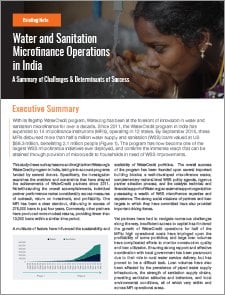
Impact Assessment — “Water and Sanitation Microfinance Operations in India: An Assessment of Challenges & Determinants of Success”
The role microfinance can play in improving access to safe water supply and sanitation among low-income populations is gaining attention, especially in light of conversations around financing the achievement of Sustainable Development Goal 6. Despite this increased attention, knowledge gaps remain regarding factors that hinder and facilitate the scale and sustainability of water and sanitation microfinance operations. This study examines the enablers and constraints that have shaped the performance of Water.org partner organizations in India between 2011 and 2015. (October 2016)
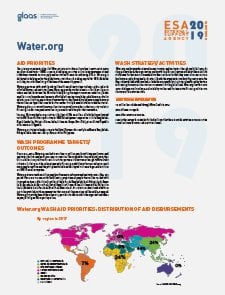
GLAAS ESA overview — About Water.org
This overview, published in the biannual UN-Water Global Analysis and Assessment of Sanitation and Drinking-Water, presents Water.org’s achievements to date in empowering millions of people living in poverty to access drinking water and sanitation through the availability of affordable, targeted finance. (April 2019)
Give the gift of safe water today.
Donate